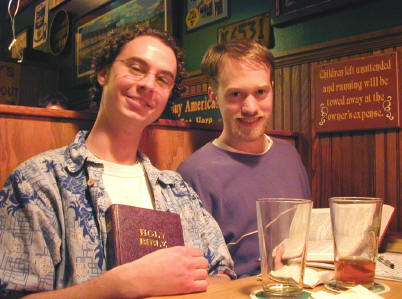
← Two aspiring young
Bible students!
The discussion begins friendly . . . →
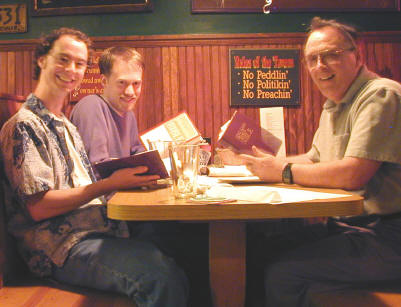
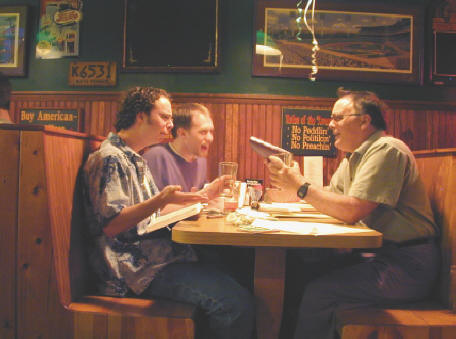
← . . . but quickly becomes heated !
Anthropology and the Bible
(over beer)
with
Adam and Tyler
(2003)
* * * * *
Discussing Mark and Matthew
at
O'Malley's
|
|
← Two aspiring young Bible students!
|
|
The discussion begins friendly . . . → |
|
|
|
← . . . but quickly becomes heated ! |
|
|
|
|
|
The Mary Magdalene Reliquary (above left) is located in a crypt beneath the Basilica to Mary Magdalene in Saint Maximin de Provence, France (above center) where Mary Magdalene is purportedly buried. The reliquary contains what many believe is Mary Magdalene's skull (see above right). According to local beliefs, Mary Magdalene left Palestine with Mary (the mother of Jesus) and Mary (the aunt of Jesus) and landed at what is today known as Sts. Marie de la Mer, a small village on the Mediterranean south of St. Maximin. According to local tradition, Jesus' mother and aunt remained in Sts. Marie de la Mer, while Mary Magdalene left the village to live naked (with just her long hair covering her body) as a hermit for 33 years in a cave at Baume (southeast of St. Maximin). Each year in late May, Gypsies converge on Sts. Marie de la Mer to celebrate the landing of the three Maries in southern France.
|
|
|
St. Simeon the Stylite
The Stylite saints, or "pillar hermits" as they were known, lived austere lives on top of tall towers, some over 20 feet high. St. Simeon lived on his column for 30 years, before he died in AD 459. In order to demonstrate his piety, Simeon stood on one leg for a year. He also tied a rope around his waist so tightly that his lower body became putrified and infested with maggots. According to Butler's Lives of the Saints, Simeon ate the maggots, proclaiming, "Eat what God has given you."
|
|
|
Acts and Paul
at
Ringer's Roost
|
|
← Ringer's is always a good place to teach a course. It should be designated an official Muhlenberg classroom! |
|
A friendly salute before we begin →
|
|
Both Adam and Tyler scrutinize the Bible VERY closely!
|
Adam
|
|
Tyler |
To the King George . . .
to discuss
Jesus
by
Jean-Paul Audet
(Adam's uncle)
|
Trying to add a little class to the course →
(which it desperately needs!)
|
|
|
|
← Is Adam grinning because he is enjoying the discussion, or because his glass is already half empty? |
|
|
It looks as though both of us are getting a little plastered!
|
St. Agatha
St. Agatha, a native of Sicily, lived during the third century. She is the patron saint of Malta, bell-makers, diseases of the breast, earthquakes, fire and sterility. She defended her virginity against Quintinian, a Roman consul, who wanted her for his wife. She refused him because she had already dedicated herself to God as a virgin. He had her racked, scourged and branded and had her breasts cut off. (These were later restored by divine intervention.) She was then put in a brothel where her virginity remained intact; burned at the stake but failed to ignite; and finally beheaded. Sicilians honor her feast day every year by carrying an image of her breasts through the streets.
|
The Martyrdom of St. Agatha Giovanni Battista Tiepolo (1755)
|
Its back to
The King George
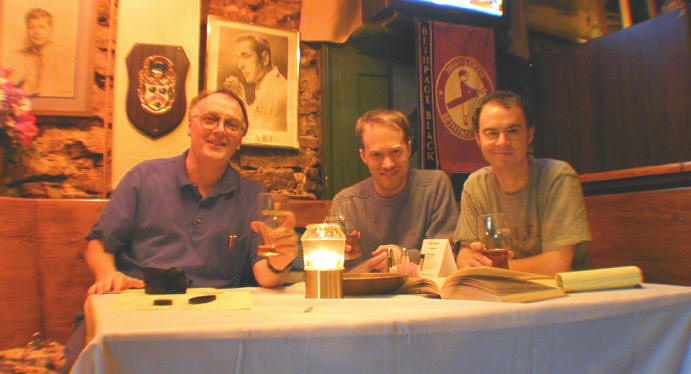
to discuss
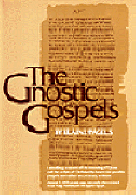
|
|
← These Gospels completely contradict Matthew, Mark, Luke and John. They also refer to Mary Magdalene as "The One Who Knew the All." How do we interpret that? |
|
Well, I guess that was a heavy issue. Time for another break. →
|
|
|
|
← Wait a minute. Doc A's glass is empty. |
|
Class is over!
|
Suggested Readings
|
From Jesus to Christ by Paula Fredriksen (2000)
|
The Gnostic Gospels by Elaine Pagels (1989) |
Jesus the Jew by Geza Vermes (1990) |
The Five Gospels Roby Robert Funk & the Jesus Seminar (1996)
|
The Other Bible by Willis Barnstone (1984) |
|
|
James: The Brother of Jesus by Robert Eisenman (1997)
|
|
The Nag Hammadi Library edited by James M. Robinson (1990)
|
|
Dead Sea Scrolls Uncovered by Robert Eisenman (1993)
|
|
Some Additional Readings
1. S.G.F. Brandon. Jesus and the Zealots. New York: Charles Schribner's Sons. 1967.
2. S.G.F. Brandon. The Trial of Jesus of Nazareth. New York: Stein and Day. 1968.
3. John D. Crossan. The Historical Jesus: The Life of a Mediterranean Jewish Peasant. San Francisco: Harper Collins. 1992.
4. A. Powell Davies. The Meaning of the Dead Sea Scrolls. London: Penguin. 1956.
5. Robin L. Fox. The Unauthorized Version. New York: Knopf. 1992.
6. Richard Elliott Friedman. Who Wrote the Bible? New York: Harper and Row. 1987.
7. Richard Horseley and John Hanson. Bandits, Prophets and Messiahs: Popular Movements at the Time of Jesus. San Francisco: Harper and Row.
8. G.N Stanton. The Gospels and Jesus. London: Oxford University Press. 1989.
9. G.A. Wells. The Historical Evidence for Jesus. Buffalo: Prometheus Books. 1988.
10. A.N. Wilson. Jesus: A Life. New York: Norton. 1992.
11. William R. Wilson. The Execution of Jesus: A Judicial, Literary and Historical Investigation. New York: Scribner's Sons. 1970.
|
|
|
|